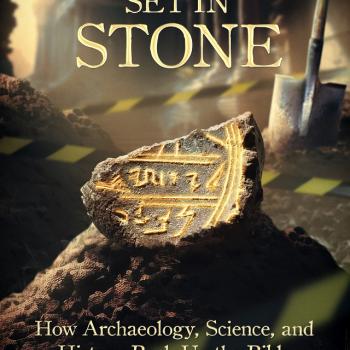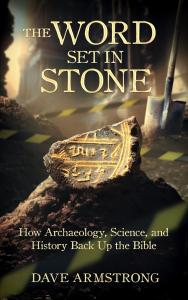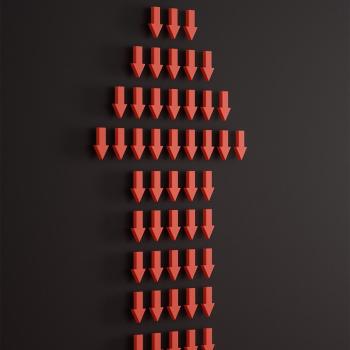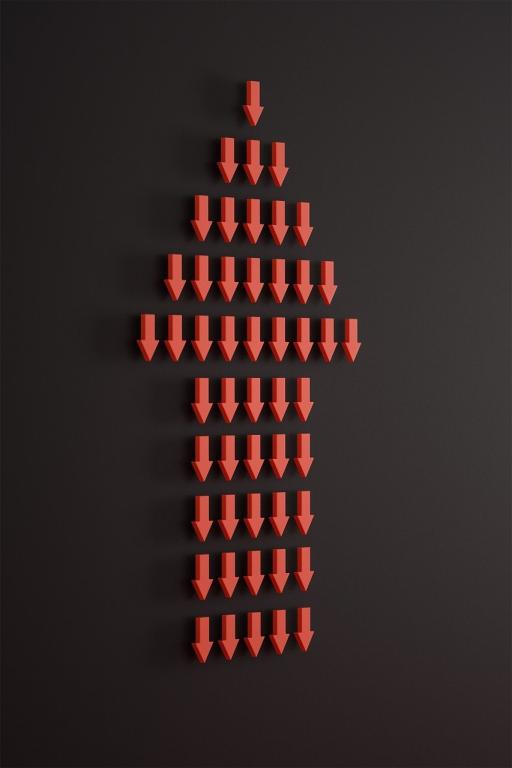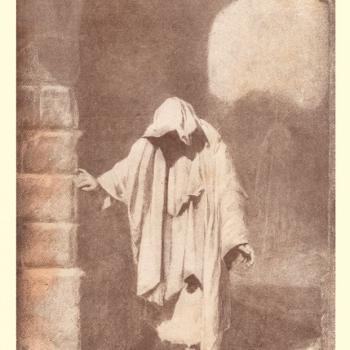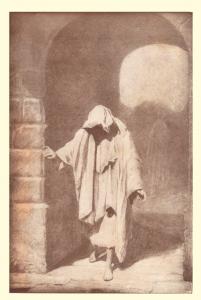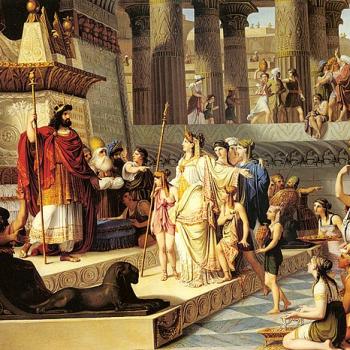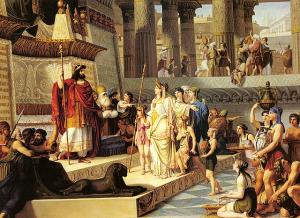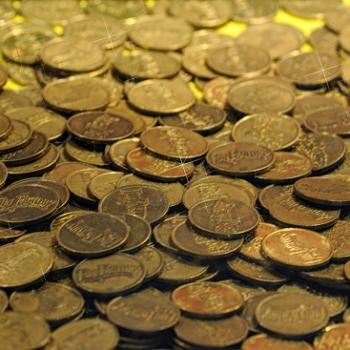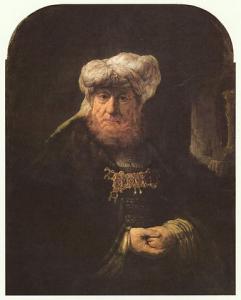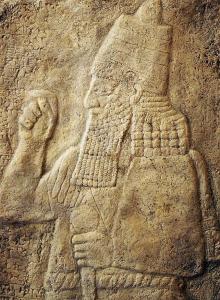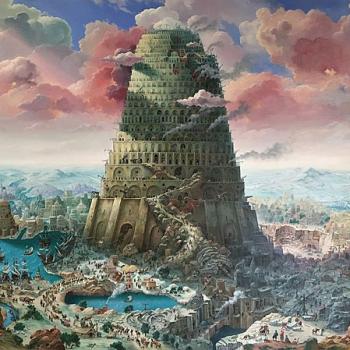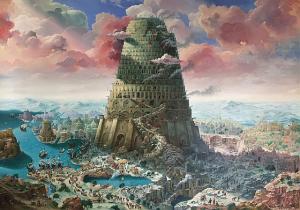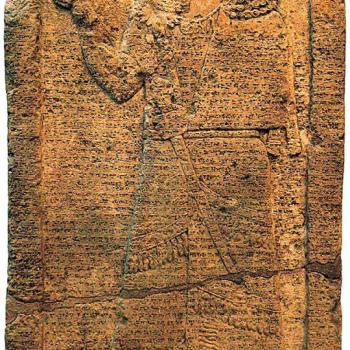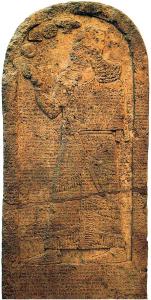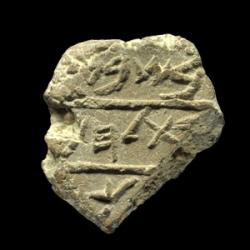[find out more about this book and purchase information]
In an atheist forum (which shall remain unnamed), a video critical of the Bible from a secular / minimalist archaeological perspective was posted. This video included a section about Jericho. So I posted much of the portion on that topic in my book, The Word Set in Stone: How Archaeology, Science, and History Back Up the Bible.
In a nutshell, I agued that the seeming absence of the archaeological layer dated around 1200 BC, when Joshua would have encountered Jericho, can be explained by a process called haloclasty, in which salt crystals become embedded in buildings and start causing them to deteriorate. Moreover, Jericho is in a desert climate, has rains for six months every year, was uninhabited for hundreds of years, and lies just 21 miles away from the Dead Sea, one of the saltiest bodies of water in the world (ten times more than the ocean), which is also the lowest elevation of any area on earth (Jericho being the lowest elevation of any city).
Then questions started being asked. I can’t quote them because then I’ll likely get in trouble (I may not even make it one day there anyway, because some are attacking me and implying that I should be kicked out). But I can summarize (and I’ll use italics for them).
One person inquired as to why remains from hundreds and thousands of years before Joshua’s conquest (as far back as 8000-7000 BC) still remain at Jericho, whereas the layer dated around 1200 does not?
It’s because (citing Wikipedia, “Jericho” for the purpose of a quick reply), “Archaeologists have unearthed the remains of more than 20 successive settlements in Jericho, the first of which dates back 11,000 years (to 9000 BCE).” But then, “Bronze Age Jericho fell in the 16th century at the end of the Middle Bronze Age, the calibrated carbon remains from its City-IV destruction layer dating to 1617–1530 BCE.” In other words, since it kept being inhabited and built over and over, on top of earlier settlements, the earlier sections were not exposed to the elements, so they have been preserved.
But then it was destroyed in c. 1530 BC, which is about 330 years before the time of Joshua’s conquest. The lack of building and preservation after that, haloclasty, the heat, and the rains would then have eroded the top layer. The article goes on to state that “There was evidence of a small settlement in the Late Bronze Age (c. 1400s BCE) on the site, but erosion and destruction from previous excavations have erased significant parts of this layer.”
This lines up with my thesis. If this small settlement, documented to c. 1400 BC survived till 1200 BC, then it was the city that Joshua conquered, but has since eroded to nothing, so that the minimalist archaeologists claim that it didn’t exist at all in 1200 BC. My thesis attempts to explain why it’s no longer there. The most recent layer simply eroded, in the unique environmental conditions that the city was subjected to.
It was objected that the Great Sphinx in Egypt (dated to the reign of Khafre, c. 2558–2532 BC) has also been subject to erosion, too, but it’s still there.
It’s not analogous because it hasn’t been subject to the same harsh environmental conditions as Jericho. This was my argument. The Sphinx is at an elevation of 85 feet above sea level, compared to Jericho’s 670 feet below sea level. Nor is the Sphinx 21 miles from the Dead Sea, the deepest hypersaline lake in the world and, with a salinity of 34.2 percent, the seventh saltiest body of water in the world—almost ten times more than the oceans. That’s why the Sphinx is still there, and 1200 BC-era Jericho ain’t. It’s not subject to the hyper-saline environment, as Jericho was.
Also, the walls of Jericho were made of mud bricks, which are especially subject to erosion from rain, as well as to salt. I was just perusing an article about ancient Babylon, that repeatedly referred to salt in the groundwater causing significant erosion to the mud bricks there. The Sphinx, in contrast, was made of limestone, and experts believe it was even under the sand for some 700 years. That would obviously help preserve it, just as I noted that older portions of Jericho under the ground and under subsequent developments of the city helped to preserve them.
Erosion happens everywhere. But other places aren’t the lowest city in the world, in extreme desert conditions, subject to yearly severe rains, and close to the seventh saltiest body in the word, which sits at the lowest elevation spot in the entire world. In other words, vastly different conditions apply in this instance.
Another atheist appeared to argue that wind conditions didn’t support my hypothesis, because they didn’t come from the south in the era, and Jericho is north of the Dead Sea.
If the point is that haloclasty proceeds primarily by means of wind, I think it’s incorrect. One article on “Weathering” noted:
Haloclasty (growth of salt crystals): Salt crystallization causes disintegration of rocks when saline solutions seep into cracks and joints in the rocks and evaporate, leaving salt crystals behind. These salt crystals expand as they are heated up, exerting pressure on the confining rock. It is normally associated with arid climates where strong heating causes strong evaporation and therefore salt crystallization.
Likewise, “About: Haloclasty” (DBpedia) opines:
Haloclasty is a type of physical weathering caused by the growth of salt crystals. The process is first started when saline water seeps into cracks and evaporates depositing salt crystals. When the rocks are then heated, the crystals will expand putting pressure on the surrounding rock which will over time splinter the stone into fragments.
None of this has to do — primarily or directly, as far as I can tell — with wind. But it could have quite a bit to do with a very salty local body of water, and to some extent, also rain. In my book I noted from experts that Jericho has a “long rainy season . . . (late October to April).” And I noted that the “water level of the Dead Sea has also greatly fluctuated over the last several thousand years—as much as 1,300 feet, the experts tell us. This means that during the time under consideration, it likely was in some periods much closer to Jericho than it is now, thus exacerbating the problem of haloclasty and the city’s erosion.”
I was asked if I found anything specifically from Jericho regarding the eroding capabilities of salt, per my thesis.
I found an article called, “Sources of salinity in ground water from Jericho area, Jordan Valley.” (Ground Water, March 2001). It stated:
One of the major problems in the lower Jordan Valley is the increasing salinization (i.e., chloride content) of local ground water. The high levels of salinity limit the utilization of ground water for both domestic and agriculture applications. This joint collaborative study evaluates the sources and mechanisms for salinization in the Jericho area. We employ diagnostic geochemical fingerprinting methods to trace the potential sources of the salinity in (1) the deep confined subaquifer system (K2) of Lower Cenomanian age; (2) the upper subaquifer system (K1) of Upper Cenomanian and Turonian ages; and (3) the shallow aquifer system (Q) of Plio-Pleistocene ages. The chemical composition of the saline ground water from the two Cenomanian subaquifers (K1 and K2) point to a single saline source with Na/Cl approximately 0.5 and Br/Cl approximately 7 x 10(-3). This composition is similar to that of thermal hypersaline spring that are found along the western shore of the Dead Sea (e.g., En Gedi thermal spring). We suggest that the increasing salinity in both K1 and K2 subaquifers is derived from mixing with deep-seated brines that flow through the Rift fault system.
As previously noted, the question of the rising or falling levels of the Dead Sea was only one tangential sentence in my book, with no documentation (my book has 393 footnotes: most from scientific articles). The overall argument doesn’t rest on this factor. The two paragraphs that I already cited above [in the thread, not here] from the National Geographic are about Petra, which is 123 miles form the Dead Sea. It explained how “Salt upwelling, the geologic process in which underground salt domes expand, can contribute to the weathering of the overlying rock.” Then it noted that “structures” in Petra “often collapsed” due to this very thing. If that can happen in Petra, all the more so in Jericho.
Add to that yearly rains for six months on end, a desert climate and a lack of maintenance of mud brick walls and buildings for several hundred years, and being 670 feet below sea level (almost the lowest in the world) and my explanation is perfectly plausible. There are many unique factors in play here. We see nothing now of that latest period of ancient Jericho. It doesn’t follow that Joshua saw nothing in 1200 BC.
I wrote earlier about how the layers were built on top of each other, as is the case in many other ancient sites. Jericho was destroyed c. 1550 BC according to Kathleen Kenyon. But there are evidences of a continuing occupation (which in my theory has to occur down to c. 1200 BC). Oxford Encyclopedia of the Bible and Archaeology (“Jericho”) states:
One of the most interesting finds from the Middle Building (just east of it on the slope) is a cuneiform tablet, attributable to the fourteenth century B.C.E. Pottery vessels found by Garstang in reused tombs 4, 5, and 13, can be attributed to the same time. Actually, tomb 5 shows vessels as early as the second half of the fifteenth and the beginning of the fourteenth centuries B.C.E.; tombs 4 and 13 , conversely, yielded vessels datable to 1375 – 1275 B.C.E. Tomb 5 also included a scarab of Thutmose III (r. ca. 1504 – 1450 B.C.E.) and one of Hatshepsut (r. ca. 1473 – 1458 B.C.E.) (a second scarab of Thutmose III was found in pit tomb 11 dating from the Iron I), while tomb 4 yielded two scarabs with the cartouche of Amenhotep III (r. 1417 – 1379 B.C.E.).
The same source states that the site was “unoccupied” after 1200 BC. But that is consistent with my account since that’s when Joshua’s conquest would have happened (which included burning of the city). I don’t have all the ins and outs worked out, as I am not an archaeologist and am only speculating, but if the city in this era was unoccupied for 3-4 centuries after 1200 (the above source says it may have been occupied again in the 9th c. BC and certainly was from the 8th-6th centuries BC), then being unoccupied for all that time could have been the cause of overwhelming erosion due to the unique environmental factors that I have enumerated.
Archaeologists Avraham Negev and Shimon Gibson, in their article on Jericho in Archaeological Encyclopedia of the Holy Land (New York: Continuum, 2003) opined that the city was not inhabited “during most of the 17th and 16th centuries” and that “if there were any buildings at this period they must have been washed away by the winter rains.” Then they state:
It is possible, however, that the Late Bronze Age II [1400-1200 BC] city of Jericho was conquered by Joshua, and that during the long period that elapsed before its resettlement . . . all remains were washed away by the rains.
They casually assume that rains alone could possibly have done all of that erosion, without even considering haloclasty. So I’m not just pulling these ideas out of thin air. One can reasonably suppose that they know a bit about erosion, and erosion by rain, since this is closely related to the excavation of archaeological sites.
More support for my view on Jericho:
Israeli archaeologist Amihai Mazar (b. 1942) has been since 1994 a professor at the Institute of Archaeology of the Hebrew University of Jerusalem, holding the Eleazer Sukenik Chair in the Archaeology of Israel. His Archaeology of the Land of the Bible (Yale University Press, 1992) is a widely used textbook for Israelite archaeology in universities. His work has resulted in the Modified Conventional Chronology being the most widely accepted framework for the Israelite chronology during the Iron Age period. He was also one of the first archaeologists to normalize the use of radiocarbon dating in Levantine and Mediterranean sites. He wrote in the above book (p. 331):
At Jericho, no remains of the Late Bronze [1300-1200 BC] fortifications were found; this was taken as evidence against the historical value of the narrative in the Book of Joshua. The finds at Jericho, however, show that there was a settlement there during the Late Bronze Age, though most of its remains were eroded or removed by human activity. Perhaps, as at other sites, the massive Middle Bronze fortifications were reutilized in the Late Bronze Age. The Late Bronze Age settlement at Jericho was followed by an occupation gap in Iron Age I. Thus, in the case of Jericho, the archaeological data cannot serve as decisive evidence to deny a historical nucleus in the Book of Joshua concerning the conquest of this city.
John M. Monson, Associate Professor of Old Testament and Semitic Languages (doctorate from Harvard), and author of The Architecture of Solomon’s Temple (Oxford University Press, 2008), adds:
[T]wo points must also be noted. First, the presence of tombs nearby confirms that there was a settlement during the period of the Israelite conquest, however small it may have been. Second, whatever walls did exist were constructed atop those of the substantial Middle Bronze Age city structures. When one considers the arid climate of the Jericho region and the intense, sporadic downpours in winter, together with the ban that Joshua placed on the city, the likely erosion of most Late Bronze Age structures atop the ancient mound makes perfect sense. (“Enter Joshua: The ‘Mother of Current Debates” in Biblical Archaeology,” ch. 19 [citation from p. 437] in James K. Hoffmeier & Dennis R. Magary, editors, Do Historical Matters Matter to Faith? [Crossway, 2012]; cites in corroboration of his view, The New Encyclopedia of Archaeological Excavations in the Holy Land, edited by Ephraim Stern, 5 vols. [Jerusalem: Israel Exploration Society and Carta, 1993], 2:679-81)
I have also seen somewhere (but I couldn’t track down the exact quote) that Dame Kathleen Kenyon, the renowned excavator of Jericho from 1952-1958 allowed for the possibility of a complete erosion of these Late Bronze walls in Jericho, in accordance with the other archaeologists whom I’ve cited.
Conclusion: there is solid archaeological support for my theory of erosion at Jericho, though the aspect of salt and haloclasty is not part of their analysis. To me, it simply strengthens the possibility, alongside annual torrential rains, as another form of known erosion, which is a plausible explanation for what we observe at the site. Moreover, LaMoine F. DeVries, in his book, Cities of the Biblical World (Wipf and Stock, 2006, p. 192) wrote:
Jericho was also ravaged by the forces of nature. . . . the city seems to have been devastated by earthquakes several times during its history. Jericho was occasionally crippled by forces of wind, torrential rains, and massive mud slides, which contributed to erosion and were potentially dangerous in a city that was built primarily of mud brick.
Norman Herz and Ervan G. Garrison, in their book, Geological Methods for Archaeology (Oxford University Press, 1998) suggest that the erosion of mud brick structures is more or less constant, leading to many successive towns on top of each other (precisely as occurred in Jericho):
Tells in the Middle East are low hills containing the remnants of successive settlements. Much of the sediment forming the tell consists of decomposed remains of mud-brick houses that collapsed and over which new mud-brick houses were built. Over time, the accumulated debris and settlement of each succeeding occupation formed the tell.
This being the case, we can see that it is altogether plausible, and indeed likely, that the top level of Late Bronze walls at Jericho, abandoned after 1200 BC, would erode in the very unique climatic conditions of the region. It had, after all, some 3,100 years to do so before modern scientific archaeology and excavations commenced. Sam Kubba provided another relevant fact for my analysis:
It is often thought that heavy torrential rains will severely erode and damage the surface of an unprotected mud wall. The clay content inherent in the brick will resist wetting, except at the surface. Natural erosion rates for vertical surfaces have recently been determined to be about 2.5 cm in twenty years. (The Iraqi Marshlands and the Marsh Arabs [Trans Pacific Press, 2011], p. 194)
I did the math. Over 3100 years, the erosion would be 4.238 yards, or 12.7 feet. A source on “natural building” adds that “unprotected horizontal surfaces, such as tops of walls, will erode much faster.” Another related book similarly states:
If the material is soft, erosion is undoubtedly fast: it has been observed that massive mud-brick walls around ancient Egyptian cities have been completely eroded, and although some of the erosion was undoubtedly by water, most must have been by wind. (Ronald U. Cooke, Andrew Warren, Andrew S. Goudie, Desert Geomorphology, CRC Press, 1993, p. 292)
An archaeological work related to Turkey remarkably confirms the above data:
[M]ud-brick buildings can last from 50-100 years . . . the bricks could retain durability only if well maintained.. . .
Mud brick is a soft, pliable material, which is subject to erosion by wind, rain, and even to human touch. . . . most processes of deterioration are physical, including erosion, moisture penetrating the surface, and exfoliation due to soluble salts (which is a chemical action but has a physical effect).
Then it was claimed that my entire argument was a form of the ignoratio elenchi logical fallacy (“apparently refuting an opponent while actually disproving something not asserted”).
I have been contending that there is good reason to believe that the wall at Jericho in 1200 BC would have eroded away in the following 3100 years. I never set out to prove that there was a wall from that time period that can be examined today. In my book, I flatly stated, “The walls from the period in question (c. 1200 B.C.) are simply not there” (p. 126, italics in original).
That was my starting assumption, and then I proceeded to offer a theory as to why they are gone now. That’s perfectly legitimate and not unreasonable and not “unscientific,” unless someone believes that all things are eternal and don’t rot and decay and erode (which is absurd). Offering explanations as I did for their absence is not a stupid fallacy. I find it to be a fascinating discussion.
Contrary to the constant digs in this forum against Christians not giving a fig about facts, being fundamentally dishonest, relentless special pleaders etc. (which is standard boilerplate — and boorish — rhetoric in all atheist forums), I’ve never seen a Christian scholar claim that Jericho was not a problem that we had to explain. We freely admit it. It raises a difficulty. I then submit a possible explanation, and I back it up with the corroboration of several archaeologists: at least for the erosion of the walls, generally speaking.
I haven’t found support for my contention that haloclasty may have played a big role in that, except for the analogy of Petra. But that doesn’t immediately make the theory false. We know that it is a factor in the region, primarily due to the Dead Sea. The question then becomes, how much it affected the later (Late Bronze Age) exposed walls of Jericho.
*****
*
Practical Matters: Perhaps some of my 4,500+ free online articles (the most comprehensive “one-stop” Catholic apologetics site) or fifty-five books have helped you (by God’s grace) to decide to become Catholic or to return to the Church, or better understand some doctrines and why we believe them.
Or you may believe my work is worthy to support for the purpose of apologetics and evangelism in general. If so, please seriously consider a much-needed financial contribution. I’m always in need of more funds: especially monthly support. “The laborer is worthy of his wages” (1 Tim 5:18, NKJV). 1 December 2021 was my 20th anniversary as a full-time Catholic apologist, and February 2022 marked the 25th anniversary of my blog.
PayPal donations are the easiest: just send to my email address: [email protected]. Here’s also a second page to get to PayPal. You’ll see the term “Catholic Used Book Service”, which is my old side-business. To learn about the different methods of contributing (including Zelle), see my page: About Catholic Apologist Dave Armstrong / Donation Information. Thanks a million from the bottom of my heart!
*
***
Summary: I reply to several atheist biblical skeptics regarding my thesis as to the erosion (mostly by salt) of the Jericho of 1200 BC that was conquered by Joshua & the Hebrews.


